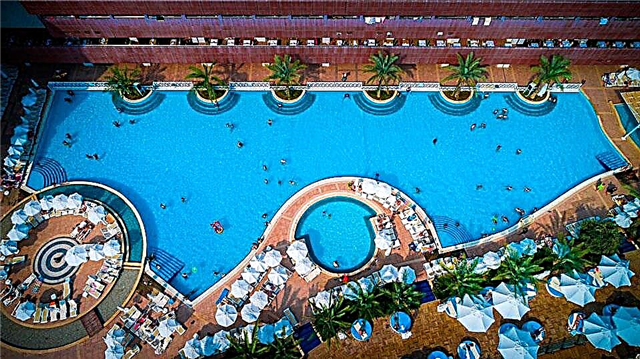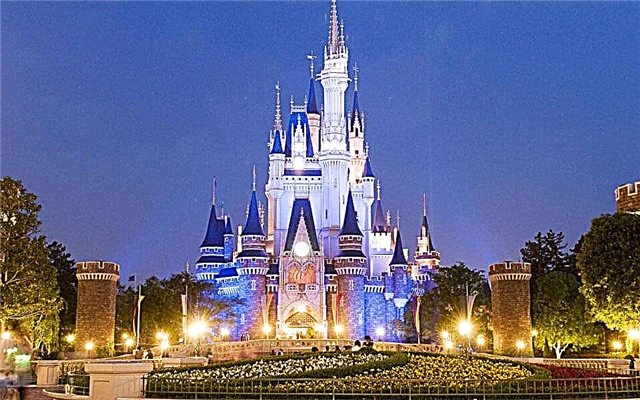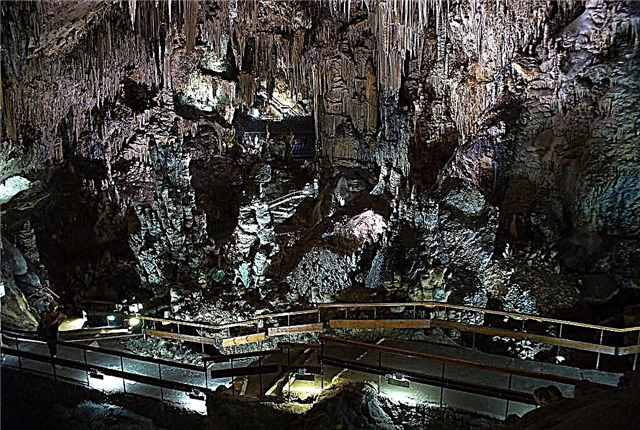Lisbon - in the distant past, the capital of a powerful maritime empire that gave the world the great Vasco da Gama and Fernand Magellan, and now a picturesque and atmospheric city that still preserves the memory of its former greatness. A dramatic and turning point in the history of Lisbon was 1755, when a powerful earthquake destroyed it almost to its foundations. But, despite the fact that medieval architecture and many priceless monuments have been lost, the restored Lisbon of the 18th-19th centuries is of great interest to tourists.
The capital of Portugal preserves the treasures of the Jeronimos Monastery and the Ajuda Palace, stretches along the quaint streets of the Alfama and Baixa quarters and flaunts grandiose suspension bridges. The historical heritage of the city is priceless, so there is a wide field for research here for tourists.

The best hotels and hotels at affordable prices.
from 500 rubles / day
What to see and where to go in Lisbon?
The most interesting and beautiful places for walking. Photos and a short description.
Praça do Comercio
The square is considered one of the most beautiful in Europe. It is located on the banks of the river, where the Ribeira Palace used to be, destroyed by an earthquake (which is why the second name of the place is Palace Square). Several centuries ago Praça do Comercio was the main gate of Lisbon. Ships with wealth exported from the Portuguese colonies moored here, and royal delegations arrived. Its former glory is evidenced by the majestic monuments and austere administrative buildings.

Augusta street
Lisbon's central pedestrian boulevard is full of tourists and locals at any time of the year. It stretches from the Rossio square to the triumphal arch. The street is replete with unusual atmospheric cafes and shops. The pavement of Augushta street is laid out by hand, on it the original ornament is woven into a whimsical pattern. The place was named after the Portuguese taxi driver Augusta Macedo, who has been taking passengers around Lisbon for almost 70 years.

Rossio square
The square arose on the site of an ancient Roman hippodrome; its history goes back more than one hundred years. The square is located in the Baixa area - one of the most colorful and interesting places in Lisbon. Until 1755, it was surrounded by luxurious Manueline buildings, as the whole city was bathed in luxury thanks to the fabulous wealth of the Portuguese colonies. After the earthquake, the entire area and area were rebuilt.

Alfama District
Almafa is the only urban area from which at least something remained after the 1755 earthquake. Its architecture with chaotically located streets corresponds to the idea of medieval cities. The area is located on a hill, people move along it using numerous stairs. Between the old houses with shabby walls, cars are unlikely to disperse, but there is room for tram lines.

Belém Tower
An architectural monument of the 16th century, included in the UNESCO list. The tower was erected in honor of Vasco da Gama's opening of the road to India, at different times it housed: a defensive fort, a powder warehouse, a prison, a customs point. The building was erected in the unique Portuguese Manueline style, almost lost by the 19th century. The facade and interior of the tower are decorated with priceless monuments of the era of the Great Geographical Discoveries.

Queluz Palace
The palace was built in the 17th century in the Rococo style. It served as the summer residence of the Portuguese king Pedro II. Later, the building was used to house dignitaries. Nowadays, classical music concerts are held on the territory of the palace. Particular attention is drawn to the luxurious Throne and Music Halls, as well as the magnificent and luxuriously decorated royal chambers.

Castle of Saint George
The castle was built in the 5th century A.D. on the site of the Roman fortification, over one and a half thousand years of its existence, it was rebuilt several times. In the XII century, it housed the residence of the Moorish ruler. Until the 16th century, Portuguese monarchs lived in the castle. In 1755, the structure was destroyed by an earthquake to its very foundations. The restoration took place only in the first half of the 20th century.

Ajuda Palace
Neoclassical building of the first half of the 19th century, built for Luis I and his wife. Earlier on the site of Ajuda there was an earlier royal residence of the XV-XVI centuries, but it was destroyed during an earthquake. The palace rooms and halls are elegantly and luxuriously furnished, the wide halls and aisles are decorated with sculptures, paintings and tapestries of great cultural value.

Belensky Palace
Residence of the Portuguese President, located in the Belém area. Earlier, during the monarchy, rulers of Portugal stayed here. The palace was erected in the middle of the 16th century and rebuilt in the 18th century. The predominant architectural styles of the complex are Baroque and Mannerism. The façade is adorned with Portuguese azulejo tiles depicting mythological heroes and epic scenes.

Jeronimos Monastery
One of the key sights of Portugal, recognized as a national monument at the very beginning of the 20th century. Since 1983 it has been included in the UNESCO heritage list. The remains of the great navigator Vasco da Gama rest in the monastery. The cloister was built towards the end of the 16th century using the income received from the newly discovered lands. The history of Jeronimos is closely associated with the grandiose period of the great geographical discoveries and the power of Portugal.

Carmelite monastery
Medieval monastery of the XIII-XIV centuries, built by the aristocrat Nuno Alvares Pereira for the brothers of the Carmelite Order. This noble knight sold all his property and got his hair cut as a monk. In 1755, as a result of an earthquake, the building was destroyed and many priceless relics were lost. After the restoration, the complex was used as a warehouse and barracks; later, an archaeological museum was placed within the walls.

Monastery of San Vicente de Fora
The complex was built in the 16th-17th centuries. on the site of the Church of St. Vincent - the patron saint of Lisbon. The monastery is one of the most revered in Portugal, for some time it was the seat of the city's archbishop. The monastery was built in the late Renaissance style. Its walls are richly laid with mosaics depicting battle scenes; the facade is decorated with azulejo mosaics. On the territory of São Vicente de Fora is the tomb of the Bragança dynasty.

Basilica da Estrela
The church, erected by order of Queen Mary, who was grateful to Heaven for the appearance of the long-awaited heir. The Basilica is considered one of the most picturesque churches in Lisbon, it was built in the Baroque style with neoclassical elements. The construction of the temple began after the Lisbon earthquake (the queen was late with the fulfillment of the promise, since at that moment her son Jose was already 18 years old).

Church of St. Roch
Jesuit Church, one of the oldest temples of this order. It was erected on the site of a cemetery in the 16th century. The temple was named in honor of Saint Roch - the patron saint of the sick. The interior is notable for its splendor; King João V took part in its creation. The walls are decorated with skillful frescoes by famous Portuguese painters, many elements of decoration are made of marble and decorated with gilding.

Lisbon Cathedral
The main cathedral of Lisbon, dating back to the early Middle Ages. It is believed that in its place there was a Roman temple, which the Visigoths turned into a Christian church. During the period of Arab rule on the Iberian Peninsula, the temple was destroyed, and a mosque was erected in its place.In 1150, a new building appeared, which stood for six centuries before the earthquake. However, the cathedral was not completely destroyed by the elements, it was reconstructed, diluting the strict Romanesque architecture with Gothic, Baroque and Neoclassicism.

Church of Saint Engracia
A majestic and monumental structure of pink marble in the Portuguese Baroque style, which has a second name - the National Pantheon of Portugal. The church began to be erected in the 17th century, and finished only in the 20th. The role of the pantheon went to the temple under the dictator A. Salazar. Political figures, famous writers and other representatives of culture are buried in the church.

Calouste Gulbenkian Museum
Art gallery, which contains samples of European, ancient and oriental art. The museum was organized at the expense of the Armenian tycoon G. Gulbenkian in 1969, who emigrated to Portugal after the Second World War. The museum exhibits a large collection of paintings, jewelry, sculpture and applied art. Here you can see the works of Rembrandt, Manet, Degas, Rubens and Renoir.

National Museum of Ancient Art
The collection is based on works of art confiscated from monastic orders. These religious associations were disbanded at the beginning of the 19th century, and part of their wealth fell into the hands of the state. The museum exhibits works by Portuguese masters of the XIV-XIX centuries, paintings by European artists, collections of sculpture and ceramics, textiles, furniture and other decor items.

National Carriage Museum
A museum that houses the collection of the royal family's carriages. It was created with the participation of the last Queen of Portugal, Amelia, as she wanted to preserve the carriages and show them to the general public. Subsequently, the collection was replenished with copies from France, Austria, Italy and other European countries. In the museum you can see carriages of the 17th-19th centuries. In 2015, a new modern building was built for the exhibition.

Electricity Museum
The museum is located in the building of a former power plant, which regularly supplied electricity to the city for several decades. The building is a rare and interesting example of Portuguese industrial architecture, mixing Art Nouveau and Classicism. In the museum, the visitor can look at the equipment, observe the processes of generating electricity or listen to an informative lecture.

Maritime museum
The exposition is located on the territory of the Jeronimos Monastery. In the distant past, Portugal was a great maritime empire, numerous colonies all over the world were subject to it. Museum exhibits remind the visitor of those glorious times. The halls exhibit various models of ships, maps, navigation devices that were used by the Portuguese discoverers in their travels.

Lisbon zoo
The city zoo is located in a very picturesque area, decorated with architectural monuments. It is home to about 300 species of animals, mainly felines, primates and animals brought from the colonial possessions of Portugal. The zoo proclaims the main goal of its existence is the preservation and revival of rare and endangered species. Some animals on the territory of the zoo are adapted for release.

Lisbon Oceanarium
The Oceanarium is considered the largest in Europe, it is home to more than 450 species of marine life (16 thousand individuals). The main aquarium covers an area of 1,000 square meters and reaches a depth of 7 meters. The aquarium contains quite rare marine species: moonfish, sea beaver, crab spider and others. In separate aquariums live the inhabitants of the Atlantic, Indian and Pacific oceans.

Elevador di Santa Justa
City lift connecting Rua do Ouro and Largo do Carmo square. It was built in the early 20th century to help pedestrians climb a steep enough slope to get from Baixa to Chiado. The elevator is designed in a graceful neo-gothic style. At first, it was driven by steam engines, later they were replaced by electric ones. The lift is a popular tourist attraction.

Monument to the Discoverers
A monument erected in honor of the leaders of the era of the great geographical discoveries. This imposing monument was built during the reign of dictator Salazar. It is distinguished by its majestic style and enormous size; the monument is 50 meters high. In this way, the architect wanted to emphasize the importance of the discoveries made by Portuguese sailors. There is a panoramic observation deck at the top of the monument.

Aqueduct Aguash Librish
The aqueduct was built in the first half of the 17th century and survived the 1755 earthquake. It is still included in the existing water supply system of the city. The arches of the aqueduct are 60 meters high. Until the middle of the 19th century, it was possible to walk on it, but it was decided to close the passage due to frequent suicides. Nowadays, you can take an excursion along the aqueduct as part of an organized group.

Bridge named April 25
60s iron suspension bridge XX century, thrown across the Tagus River and connecting two urban districts. In length, the structure stretched for 2.22 km. It is considered one of the longest suspension bridges in the world. Until 1974, the structure was named after Antonio Salazar, but after the Revolution of Red Carnations on April 25, it was renamed in honor of this significant day for Portugal.

Vasco da Gama bridge
The most impressive and longest European bridge over the Tagus River, stretching for 17 km. The grandiose structure was completed in just 3 years, despite the incredible scale of the project. The bridge was launched on March 29, 1998. This date was not chosen by chance, since it was in 1498 that Vasco da Gama set sail on the sea route from Europe to India. The bridge was built with funds from the private company Lusoponte.

Yellow lisbon tram
The narrow and uneven streets of central Lisbon have tram lines that have been in service for over a century. The famous yellow trams belong to the Lisbon tram network. Route 28 is especially popular. It passes through all the historic districts of the city, makes many sharp turns and calls into very picturesque places. Tram number 28 is constantly packed with tourists, as many people prefer to get to know the city through a trip.

Observation Decks
Lisbon is spread over the hills, often, in order to get from one area of the city to another, you need to make remarkable physical efforts and overcome many stairs and slopes. Viewpoints are scattered throughout the city, offering magnificent views of Lisbon, the Tagus River, suspension bridges, and the ocean coast. The best are the sites of Santa Lucia, Senhora do Monte, Graça, Gate of the Sun, as well as the one located on Cape Roca.












